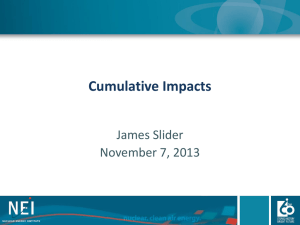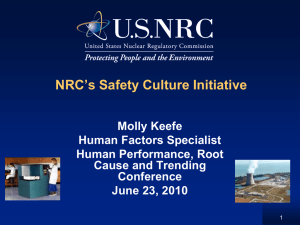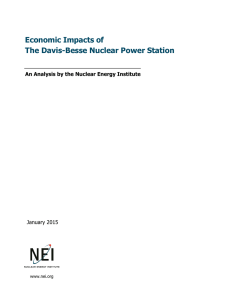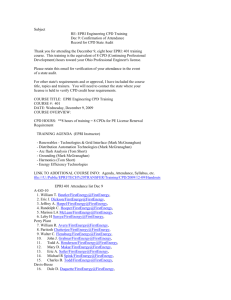Davis-Besse atomic reactor`s emergency diesel
advertisement
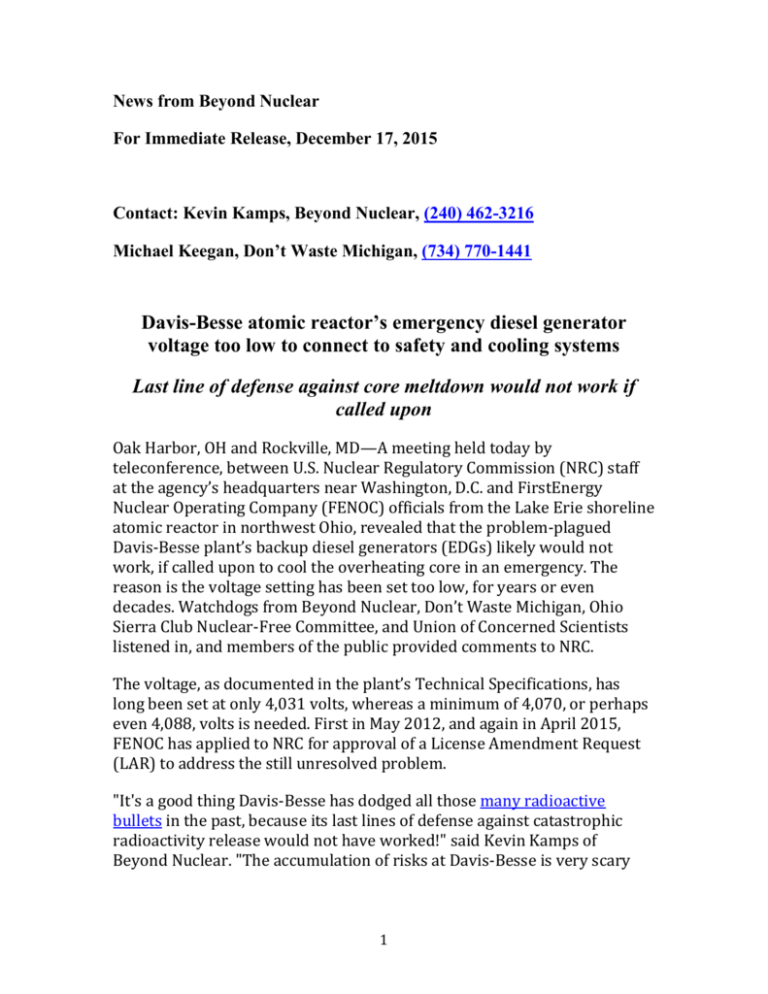
News from Beyond Nuclear For Immediate Release, December 17, 2015 Contact: Kevin Kamps, Beyond Nuclear, (240) 462-3216 Michael Keegan, Don’t Waste Michigan, (734) 770-1441 Davis-Besse atomic reactor’s emergency diesel generator voltage too low to connect to safety and cooling systems Last line of defense against core meltdown would not work if called upon Oak Harbor, OH and Rockville, MD—A meeting held today by teleconference, between U.S. Nuclear Regulatory Commission (NRC) staff at the agency’s headquarters near Washington, D.C. and FirstEnergy Nuclear Operating Company (FENOC) officials from the Lake Erie shoreline atomic reactor in northwest Ohio, revealed that the problem-plagued Davis-Besse plant’s backup diesel generators (EDGs) likely would not work, if called upon to cool the overheating core in an emergency. The reason is the voltage setting has been set too low, for years or even decades. Watchdogs from Beyond Nuclear, Don’t Waste Michigan, Ohio Sierra Club Nuclear-Free Committee, and Union of Concerned Scientists listened in, and members of the public provided comments to NRC. The voltage, as documented in the plant’s Technical Specifications, has long been set at only 4,031 volts, whereas a minimum of 4,070, or perhaps even 4,088, volts is needed. First in May 2012, and again in April 2015, FENOC has applied to NRC for approval of a License Amendment Request (LAR) to address the still unresolved problem. "It's a good thing Davis-Besse has dodged all those many radioactive bullets in the past, because its last lines of defense against catastrophic radioactivity release would not have worked!" said Kevin Kamps of Beyond Nuclear. "The accumulation of risks at Davis-Besse is very scary 1 for those living downwind and downstream, especially considering the unwise 20-year license extension NRC just rubber-stamped," he added. In addition to the EDGs' inability to cool the core if off-site power were lost, Kamps was also referring to the concrete containment Shield Building. It has been of dubious structural integrity since January 1978, which, according to FENOC, is when it became severely cracked. The company further admits significant crack growth, due to ice-wedging, has taken place ever since late 2012. "Ironically enough, northern Ohio is very lucky the Hole-in-the-Head shut down Davis-Besse from 2002 to 2004," Kamps said. "If it had been operating in August 2003, when the grid went down for 50 million people in the U.S. and Canada because FirstEnergy neglected to trim a tree branch that touched a power line, the EDGs at Davis-Besse would not have prevented a core meltdown, and the cracked Shield Building would not have contained the catastrophic radioactivity release," Kamps added. “NRC approved the license extension, even though this EDG concern has remained unresolved since May 2012,” said Michael Keegan of Don’t Waste Michigan in Monroe. “FENOC must also still file an LAR to restore current licensing and design basis, due to violations involving Shield Building cracking dating back to October 2011. How many more LARs remain unresolved?” Keegan asked. BACKGROUND ON EDGs and NUCLEAR STATION BLACKOUT RISKS On December 14, 2015, David Lochbaum, director of the Nuclear Safety Program at Union of Concerned Scientists, lodged an official allegation with NRC, which stated: My allegation is that the Davis-Besse licensee knew on or before May 23, 2012, that the minimum voltage limit for the emergency diesel generators was non-conservative and could prevent proper, safe operation of the emergency diesel generator. I've searched ADAMS and the NRC website looking for a Notice of Enforcement Discretion and/or a Licensee Event Report on EDG minimum voltage at Davis-Besse. I've not found any such documents. My allegation is that the owner is deliberately operating Davis-Besse outside the plant's design and licensing bases with a known safety impairment. 2 By its own admissions, the owner knows that the minimum voltage limit in the technical specifications for the emergency diesel generators is inadequate to ensure that the plant responds as assumed in the safety studies reviewed by the NRC in granting the operating license, and more recently, the renewed operating license. And yet there's no evidence that the owner sought a Notice of Enforcement Discretion to allow Davis-Besse to continue operating despite being outside its current licensing basis. And there's no evidence that the owner submitted a licensee event report to the NRC for deliberately operating Davis-Besse outside its design and licensing basis. On December 16, 2015, Lochbaum further explained that: The output breakers connect the emergency diesel generator to their respective 4,160 volt electrical buses. In the schematic [see "Davis-Besse Electrical Distribution System," linked here], AC101 is the output breaker for emergency diesel generator 1 while AD101 is the output breaker for emergency diesel generator 2. These output breakers are open when the EDGs are in standby. The electrical buses are supplied from the 13,800 volt buses via the bus tie transformers. When electrical power is lost or degraded, the EDGs automatically start. When they are running and developing proper voltage <at the heart of the license amendment request issue> the output breakers close to re-power the 4160 volt buses. The output breakers are opened and closed automatically using electricity. The license amendment request seeks to increase the minimum voltage for the EDGs from 4031 volts to 4070 volts. The torque required to move the output breaker from its open position to the closed position may require more force than can be provided by 4031 volts. The station blackout events at Vogtle Unit 1 [in Georgia, U.S.A.] in the early 1990s and at Forsmark [in Sweden] a decade later were caused when offsite power was lost and the onsite EDGs started but their output breakers failed to close. Those causes were different from Davis-Besse's insufficient voltage cause, but the consequences are the same -- the EDGs are transformed from sources of electricity into expensive room heaters. (emphasis added) That is, there are serious questions, dating back to at least May 23, 2012, regarding whether, or not, if they had been called upon in an actual emergency, Davis-Besse's emergency diesel generators would have worked properly, or at all. EDGs are the final line of defense against a meltdown when the electric grid is lost to run safety and cooling systems. Lochbaum's comments came in the context of his analysis of an April 10, 2015 NRC Component Design Basis Inspection (CDBI) Report, which revealed that 3 even on "highly important" systems, structures, and components, DavisBesse barely gets a passing grade. Lochbaum also noted that "Oddly enough, even though the CDBI team wrote that it looked at the battery charger and load calculations to check whether there was sufficient voltage to close the EDG output breaker, they didn't notice that there's insufficient voltage to close the output breaker. FirstEnergy's April 1, 2015, license amendment request seeks to provide sufficient voltage." Left unexplained is how an NRC report dated April 10, 2015 could miss the problem with insufficient voltage, not only admitted to by FirstEnergy's April 1, 2015 License Amendment Request, but by its earlier 2012 LAR that was subsequently withdrawn (again, for unexplained reasons, other than that FirstEnergy did not want to provide the additional information required by NRC at the time.) Lochbaum has also explained the significantly increased risks of a core meltdown, in the event of nuclear station blackout. He wrote about it six days after the Fukushima Daiichi nuclear catastrophe began in Japan – about which he later co-authored the book, Fukushima: The Story of a Nuclear Disaster (New Press, 2014). The August 2003 NRC report (Regulatory Effectiveness of the Station Blackout Rule, NUREG-1776) which Lochbaum cited includes a table, "Plant Specific Station Blackout Information" (on Page B-2, or 48 of 91 on the PDF counter), showing that 53% of the Core Damage Frequency risk at DavisBesse comes from Station Blackout risk. Despite this, Davis-Besse’s DC batteries would last only four hours. (Even though Fukushima Daiichi’s batteries lasted eight hours, they were nonetheless unable to prevent three meltdowns.) The NRC’s claim that Davis-Besse’s EDGs are 95% reliable is highly dubious, given the new revelations of insufficient voltage. --30-- 4


